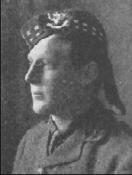
|
ArchiestownWar Records |
| 2nd Lieutenant Robert James SMITH | |
|
1/6th (Morayshire) Battalion Seaforth Highlanders Date of birth: 13th October 1889 Date of death: 13th November 1916 Killed in action aged 27 Buried at Mailly Wood Cemetery, Plot I Row F Grave 29 |

|
| Robert James "Knockando" Smith was born at East Mains, Knockando on the 11th October 1889, the second son of John Smith, a farmer, and Mary (nee Philip) Smith of Easter Mains, Knockando. He was educated at Knockando Public School and at Aberdeen University from 1910 where he studied agriculture. He stayed in lodgings at 22 Esselmont Avenue, Aberdeen. He obtained his University Diploma in Agriculture in 1913 and the National Diploma in Dairying. He passed his final examination to obtain the National Diploma of Agriculture, with Distinction, in April 1914. While he was at university he enlisted at Aberdeen in U Company (University Company) 4th Battalion Gordon Highlanders as Private 1228 on the 1st of November 1911. At a medical examination, which took place on the 22nd of November, it was recorded that he was five feet nine inches tall and that he weighed 182lbs. He attended their annual camp in 1912 from the 20th of July to the 3rd of August 1912 but was exempted from the 1913 camp. He was known at university and in the battalion as "Knockando". On leaving university he obtained a post in the Land Valuation Department of the Inland Revenue. Following the outbreak of war he was mobilised on the 5th of August 1914 and reported for duty at Aberdeen when he was placed in D Company. He went with them to Bedford for further training. He embarked for France with his battalion at Southampton on board HMT "Archimedes" on the 19th of February 1915, sailing at 7pm. They landed at Le Havre the following morning. On the 2nd of April 1915 he was admitted to 8 Field Ambulance at La Clytte suffering from diarrhoea. Robert Smith was badly wounded by a gunshot in the chest on the 25th of April 1915 while in trenches near the Menin Road in the Ypres Salient with A Company. He was evacuated to 13 General Hospital at Boulogne on the 27th of April and was loaded on board the Hospital Ship "St Andrew" to return for treatment in England on the 29th of April 1915. Following his recovery he was commissioned as a 2nd Lieutenant in the Seaforth Highlanders on the 25th of August 1915, training at Ripon and at Edinburgh before he embarked to return to the front on the 1st of September 1916 where he and two other officers joined the 1/6th Battalion of his regiment in the field at Bailleul on the 21st of September 1916. On the morning of the 13th of November 1916 the battalion was part of an attack to capture the village of Beaumont Hamel on the Somme. The village had resisted capture since the 1st of July when the 29th Division had suffered terrible casualties in their attempt to take it on the first day of the battle. The 1/6th Battalion was detailed to be in the fifth and sixth waves of the 51st Highland Division assault that morning. At 5.45am a mine was detonated under the Hawthorn Ridge and the first waves moved forward. They passed over the jumping off trenches without incident but found themselves getting ahead of the leading wave and had to hold their ground for a short while. The leading battalions of the 1/7th Argyll and Sutherland Highlanders and the 1/5th Seaforths captured the German first line trench and the 1/6th Seaforths passed through them and headed for the second line. Here fierce resistance was encountered and the men became scattered. Lieutenant James Bliss rallied men from C and D Companies along with some men from the 1/5th Seaforths and pushed on to the outskirts of the village but they were driven back to the second line by enemy machine gun fire. The party then set about clearing the second line enemy dugouts and consolidating their gains. Further north A Company had been tasked with the capture of two caves and this was achieved with the capture of a large number of prisoners, a feat which won one of their leaders, 2nd Lieutenant George Edwards, the Distinguished Service Order. Robert Smith was killed by a shell while leading his men against the third enemy line. His body was recovered on the 20th of November and he was buried the following morning at 9am. His commanding officer, Lieutenant Colonel Graham wrote;- "I have been his Commanding Officer for three months, during which time I knew him to be a splendid platoon commander, and always keen and anxious to do his duty. I regret his death very much, as he was the type of officer who can ill be spared." His friend 2nd Lieutenant Morrison wrote;- "Robert and I were in the same company and I learned to regard him much as a brother. His simple, honest, unassuming ways made him a general favourite amongst brother officers and men and I felt proud to have the companionship of such a genuine fellow." He is commemorated on the war memorial at Aberdeen University. |
|
| East Mains |
Back